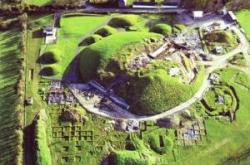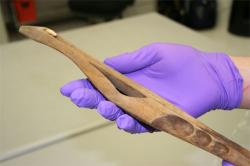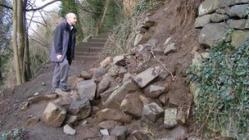15 DECEMBRE
INDI-UNI : ANTHROPOLOGY - ARCHAEOLOGY
INSCRIPTION 2012 COURS A DISTANCE
REGISTRATION 2012 ONLINE COURSES
IRLANDE –  Knowth - New archaeological relics from the Neolithic era have surfaced in Knowth, Co Meath, reports the Meath Chronicle. The new finds were discovered at an area just southeast of the passage tomb cemetery at Brú na Binne, which has been the focus of Professor George Eogan’s study for the past few decades. At the site, a “number of previously unknown large-scale monuments” have been discovered. Joe Fenwick, a member of the archaeology department at NUI Galway, conducted a number of “noninvasive, topographical” surveys of the area in conjunction with Professor George Eogan. With their study, the team has discovered “a complexity of sub-surface wall-footings, earth-filled ditches, and post-pits...This research confirms that the archaeological footprint of Knowth extends over a far greater area than previously thought,” notes The Meath Chronicle. “A large double-ringed oval measuring 65m across its minor axis and a sub-rectangular ditched enclosure with internal features measuring over 70m in maximum dimension,” are the most apparent images gathered from the tests conducted on the area. While the meaning or exact date of the new discoveries is not completely known just yet, they do suggest the overlapping of successions of different populations in the area, ranging from the Neolithic period until today. The archaeologists working at the site noted that, without exact dating, only “tentative interpretations” about the site can be made for now. Other discoveries made around Knowth include undecorated stones built into satellite tombs, and some structural remains which is speculated to be part of an ancient chapel. Most notably however, is a stone bearing an ancient spiral design from the megalithic tradition.
Knowth - New archaeological relics from the Neolithic era have surfaced in Knowth, Co Meath, reports the Meath Chronicle. The new finds were discovered at an area just southeast of the passage tomb cemetery at Brú na Binne, which has been the focus of Professor George Eogan’s study for the past few decades. At the site, a “number of previously unknown large-scale monuments” have been discovered. Joe Fenwick, a member of the archaeology department at NUI Galway, conducted a number of “noninvasive, topographical” surveys of the area in conjunction with Professor George Eogan. With their study, the team has discovered “a complexity of sub-surface wall-footings, earth-filled ditches, and post-pits...This research confirms that the archaeological footprint of Knowth extends over a far greater area than previously thought,” notes The Meath Chronicle. “A large double-ringed oval measuring 65m across its minor axis and a sub-rectangular ditched enclosure with internal features measuring over 70m in maximum dimension,” are the most apparent images gathered from the tests conducted on the area. While the meaning or exact date of the new discoveries is not completely known just yet, they do suggest the overlapping of successions of different populations in the area, ranging from the Neolithic period until today. The archaeologists working at the site noted that, without exact dating, only “tentative interpretations” about the site can be made for now. Other discoveries made around Knowth include undecorated stones built into satellite tombs, and some structural remains which is speculated to be part of an ancient chapel. Most notably however, is a stone bearing an ancient spiral design from the megalithic tradition.
http://www.irishcentral.com/roots/Archaeologists-discover-new-ancient-burial-site-at-Knowth-135650443.html#ixzz1gcnYtwjZ
CHINE - Yungang Grottoes - Another great discovery was recently made in the 2011 expedition of the Yungang Grottoes, which has been followed closely by the archaeological field at home and abroad. This finding not only confirms the presence of metallurgical casting bases in the eras of Song, Liao and Jin described in "Heavenly Creations," China's encyclopedia in the 17th century, but also mirrors the different construction styles and prosperity of Yungang grottoes in the Northern Wei, Liao and Jin periods. In the Buddhist monastery site during the Northern Wei and Liao Jin dynasties discovered earlier, archaeologists found ruins of a large casting workshop, which included a crypt casting well bay and 30 blast furnaces and wells. The Yungang Joint Archaeological Team leader and Shanxi Provincial Institute of Archaeology researcher Zhang Qingjie said that the newly found Liao and Jin casting workshop was on the tops of the fifth and sixth grottoes of Yungang. Unearthed objects also include tower bases, stone column bases, potteries, bowls and eaves tiles in design of animal faces in addition to casting well bays, blast furnaces and wells. These are currently the Song, Liao and Jin casting ruins found most close to those recorded in Heavenly Creations.
http://english.peopledaily.com.cn/90782/7677761.html
CHINE - Zhougong Temple site - An archaeological team made up of archaeologists from the School of Archaeology and Museology under Peking University and Shaanxi Archaeological Research Institute has unearthed more than 10,000 tortoise shells at the Zhougong Temple site in Shaanxi province. These tortoise shells date back to the Western Zhou dynasty and were engraved with nearly 2,600 recognizable characters. A tortoise shell unearthed in late November presents a scene of two people practicing divination simultaneously for the first time. Lei Xingshan, head of the archaeological team and a professor from Peking University’s School of Archaeology and Museology, said that since the beginning of excavations on the Zhougong Temple site in 2004, they have pieced together the tribal structures during the Shang and Zhou dynasties. Lei said the unearthed tortoise shells record information about dream interpretation, ancestor worship, troop movements and other matters.Tortoise shells found in one pit were once used by the Duke of Zhou, also known as Zhou Gong. “Previously, archaeologists found no more than 1,100 characters engraved on Xizhou tortoise shells. The large amounts of tortoise shells found at the Zhougong Temple site are enough to bring about a qualitative change in the inscriptions study of the Xizhou tortoise shells,” Lei said.
http://english.peopledaily.com.cn/90782/7677985.html
ROYAUME UNI – Finn Cop - Archaeological excavations in the Peak District are in the running for a national award and support from the public can make all the difference. The excavations at Fin Cop, an Iron Age hill fort overlooking Monsal Dale, near Bakewell, rose to national significance when unexpected evidence of a prehistoric massacre was revealed. Skeletal remains of several young women and children were found thrown into a ditch with the ramparts pushed over them more than 2,000 years ago. The project included digs carried out over two summers in 2009 and 2010 followed by extensive laboratory analysis and research.
http://www.thestar.co.uk/news/public_urged_to_vote_for_peak_archaeology_dig_site_1_4057884
ROYAUME UNI – Preston - The foundations of a medieval manor remained hidden during a community archaeology dig. The site, near Marbles Way, was excavated by archeologist Brian Hope Taylor in the 1950s, but his work was never formally recorded. A series of public excavations were held there last month, but the amateur archaeologists, guided by professionals from Surrey County Council, were unable to uncover the flint foundations. Abby Guinness, community archaeologist at Surrey County Council, said: "It's been difficult to find the chapel walls that Brian Hope Taylor uncovered in the 1950s – possibly as a result of the subsequent building in the area. However, this project will run until summer 2012, and there is plenty more we can do."
http://www.thisissurreytoday.co.uk/Community-dig-fails-reveal-medieval-manor/story-14091972-detail/story.html
USA –  Birnirk - A large collection of archaeological artifacts has returned to Alaska, nearly 60 years after the items were excavated near Point Barrow. The Birnirk collection represents a phase of prehistoric Eskimo culture dating back to 500 A.D. “The Birnirk site is the ‘type site’ for the Birnirk culture, which occupies a key juncture in the branches of Eskimo prehistory and the first decidedly Eskimo phase of cultural development seen on the Alaska mainland. The collection was excavated in the early 1950s by a group of Harvard graduate students headed by Wilbert Carter. The collection contains almost 26,000 items, ranging from hunting tools and harpoon parts to snow goggles and snow knives. The site also offered excellent organic material preservation, producing an exceptionally complete catalog of prehistoric materials, such as wood, bone, antler and even plant fibers. Carter never published a final report on the site. So the data and the documentation have great research potential, both in terms of bringing unpublished data to light and applying modern analytical techniques.
Birnirk - A large collection of archaeological artifacts has returned to Alaska, nearly 60 years after the items were excavated near Point Barrow. The Birnirk collection represents a phase of prehistoric Eskimo culture dating back to 500 A.D. “The Birnirk site is the ‘type site’ for the Birnirk culture, which occupies a key juncture in the branches of Eskimo prehistory and the first decidedly Eskimo phase of cultural development seen on the Alaska mainland. The collection was excavated in the early 1950s by a group of Harvard graduate students headed by Wilbert Carter. The collection contains almost 26,000 items, ranging from hunting tools and harpoon parts to snow goggles and snow knives. The site also offered excellent organic material preservation, producing an exceptionally complete catalog of prehistoric materials, such as wood, bone, antler and even plant fibers. Carter never published a final report on the site. So the data and the documentation have great research potential, both in terms of bringing unpublished data to light and applying modern analytical techniques.
http://www.sitnews.us/1211News/121411/121411_artifacts.html
ROYAUME UNI –  Stirling Castle - A section of wall below Stirling Castle that collapsed last week is now the subject of an archaeological investigation. The wall was on a steep bank above the Butt Well and had been built to retain garden terraces created in the 1490s. Archaeologists are using the collapse as an opportunity to investigate fragments of one of Scotland's oldest gardens, made for James IV. An initial survey of the collapsed wall using GPS has been carried out by AOC Archaeology, and SLHS hope a more detailed survey and a full dig could take place in the future.
Stirling Castle - A section of wall below Stirling Castle that collapsed last week is now the subject of an archaeological investigation. The wall was on a steep bank above the Butt Well and had been built to retain garden terraces created in the 1490s. Archaeologists are using the collapse as an opportunity to investigate fragments of one of Scotland's oldest gardens, made for James IV. An initial survey of the collapsed wall using GPS has been carried out by AOC Archaeology, and SLHS hope a more detailed survey and a full dig could take place in the future.
http://www.bbc.co.uk/news/uk-scotland-tayside-central-16195566